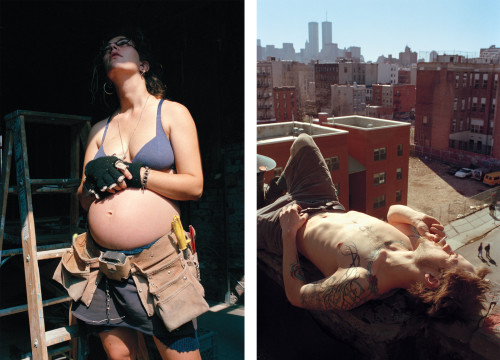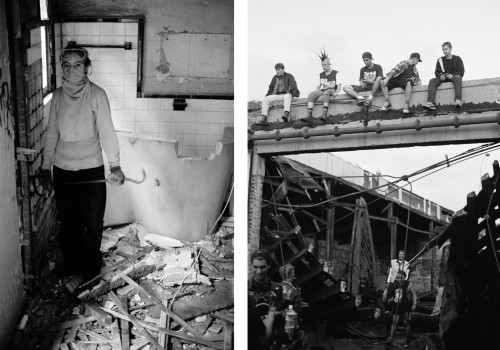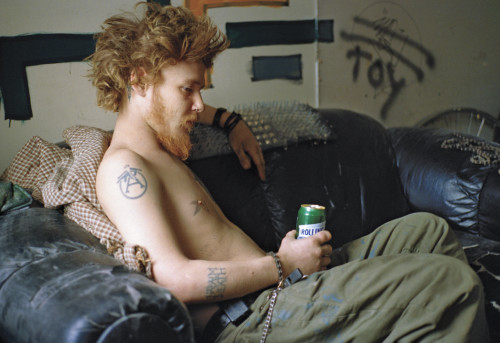Image above: ©Ash Thayer, Jason, Fifth Street Squat, 1994. Courtesy of powerHouse Books.
Kill City by Ash Thayer is a beautiful and intimate photo documentary of Lower East Side squatters in New York from 1992 to 2000. Thayer immersed herself in punk culture as a teenager, moving out of her parents’ house to live with a group of punk rock girls who helped her channel suppressed rage from social traumas in grade school into artistic expression and social activism. She was then introduced to the world of squatters in 1992 when she moved from Memphis to New York to study at the School of Visual Arts. Even with a partial scholarship and loans, she struggled to make rent and was eventually taken in by a “local young punk guy” she had been running into at Tompkins Square Park and punk shows. Punk culture clearly embraced the squatter mentality that Thayer portrays in her book.
To the outside world that sees nothing but dirty “crusties” living like rats in unsanitary conditions and freeloading off the rest of hardworking society, this book serves as a reminder that not everyone defines “a better way of life” the same way. The squatter culture is deeply rooted in values that are actually quite universal, once outer identities are stripped down to the barest of human needs and desires: basic survival, creative urges, intimacy and love. It is often in such conditions that the purest art is born, conditions that also give a district the reputation of being ready for modernization and gentrification, ready for takeover by profitmotivated investors who bulldoze and criminalize anyone whose culture doesn’t comply with the presupposed terms and conditions of living on the grid. Squatting is essentially going off the grid, but within the grid, arguably making it an even bigger diss to society.
 Images above: ©Ash Thayer, (left) Famous, pregnant and building windows, Seventh Street Squat, 1994. (right) Lower East Side Squatters. Courtesy of powerHouse Books.
Images above: ©Ash Thayer, (left) Famous, pregnant and building windows, Seventh Street Squat, 1994. (right) Lower East Side Squatters. Courtesy of powerHouse Books.
Narrative excerpts from squatters chosen by Thayer assert and defend the stance against gentrification, which punk and squat kids alike consider to be the slow mass genocide of their culture. Perhaps to officials looking to beautify the city, and to police officers trying to keep communities free of “Broken Windows”, it’s not that personal, it’s really very simple; to be a constructive and productive member of society means coloring within the lines delineated by law, so punk identities will inevitably be marginalized as misguided rejects that haven’t found a constructive way to channel their anger. This is precisely the kind of myth about squatters and punk kids that Thayer strives to dispel, challenging the socially engrained schema of their culture projected by institutions and mass media.
Kill City is not a glorification of the sex, drugs, and rock and roll culture, but rather a protest of that simplified stereotype. Thayer purposely avoided the kind of overt vulnerability and intimacy that people would naturally expect from a portrayal of squat culture. She presents the Lower East Side squats as a community for nonconformist spirits whose lifestyle and ideals were criminalized and cast away. She wanted to show her friends as she knew them: “hardened kids being transparent and productive”, engaging in community meetings, protesting society’s throwaway mentality of the homeless, making art, building everything from stairs and flooring to insulation, working parttime jobs like construction and tablewaiting to raise money for materials, and hosting the kind of parties that wellheeled hipsters try to emulate in commercialized spaces.
 Images above: ©Ash Thayer, (left) Ryan cutting a window guard, Dos Blockos, 1996 (right) Beer Olympics I, Williamsburg, 1994. Courtesy of powerHouse Books.
Images above: ©Ash Thayer, (left) Ryan cutting a window guard, Dos Blockos, 1996 (right) Beer Olympics I, Williamsburg, 1994. Courtesy of powerHouse Books.
Some of the most moving images in the book are the ones of squatters watching as the makeshift homes they built with their bare hands are demolished, with their belongings inside. The threat of eviction always loomed outside the boarded windows and doors of squat houses. Despite a spirited fight, in 2000, the last of the squats officially began the process of being converted to coops. You have to pay to live anywhere on the grid, but for those who had the heart and fighting spirit to hold out as long as they did, many of their realest moments were documented by Thayer for them to remember, and for history to remember. Despite a mainstream education at SVA, Thayer says in her prologue that she didn’t want to shoot fashion, advertising, or anything else that would support corporate America. Her work is a clear political statement that fights for change and sees beauty in the “warriors” who fight for change, a counterforce to the zoning, regulation, and censorship of any culture that doesn’t comply with or feed the system.
 Image above: Jason, ©Ash Thayer, Ryan on couch (toy), Fifth Street Squat, 1995. Courtesy of powerHouse Books.
Image above: Jason, ©Ash Thayer, Ryan on couch (toy), Fifth Street Squat, 1995. Courtesy of powerHouse Books.
By Lana J. Lee



